A Neural Network Trained by Multi-Tracker Optimization Algorithm Applied to Energy Performance Estimation of Residential Buildings
Abstract
1. Introduction
- Employing a novel metaheuristic optimization, namely multi-tracker optimization algorithm (MTOA) [31] to assist a popular predictive model, i.e., feed-forward neural network (FFNN), for energy analysis in residential buildings. The MTOA benefits from both local and global search merits to find the optimal solution to the problem at hand. Scholars such as Zhao, et al. [32] and Liang, et al. [33] have professed the high potential of this algorithm in optimizing ANNs for prediction tasks.
- Developing a predictive model capable of the simultaneous estimation of annual thermal energy demand (ATED) and annual weighted average discomfort degree-hours (WADDH) by analyzing the building circumstances.
- Optimizing the solution via sensitivity analysis on the model configurations.
- Validating the developed models with respect to the previous literature and underlining the improvements.
- Moreover, by fulfilling the above steps, this study introduces a fast, accurate, and inexpensive way for the early prediction of building energy performance, which can result in a more efficient design of the building itself, as well as energy-related systems (e.g., heating, ventilation, and air conditioning (HVAC)).
2. Materials and Methods
2.1. Data and Statistics
2.2. Multi-Tracker Optimization Algorithm
2.3. Comparative Algorithms
3. Results and Discussion
3.1. Accuracy Measurement Method
3.2. Integration of MTOA and FFNN
- (i)
- A general FFNN model was deployed associated with the training data. By doing this, the non-linear contribution between the targets and inputs is established.
- (ii)
- The structure of the FFNN was determined based on the authors’ experience supported by a trial-and-error procedure. As the topology of the FFNN is shown in Figure 3, it has eleven input neurons (one for each input of the dataset), seven middle neurons, and two output neurons (that release the ATED and WADDH).
- (iii)
- The internal parameters of this network are 91 weights and nine biases that were extracted and organized using the commands getwb (Network) and separatewb (Network, weights and biases) in MATLAB.
- (iv)
- The FFNN mathematical equations for predicting the ATED and WADDH were created, wherein, the weights and biases are variables.
- (v)
- The MTOA (as well as three benchmarks) was deployed to optimize the created equations. For this purpose, the FFNN equations are yielded to MTOA as the problem function. The outcome was a training error, which in this work is represented by RMSE (Equation (4)) averaged for the ATED and WADDH.
- (vi)
- Hyperparameters of the algorithms such as 1000 iterations were determined. The FFNN-MTOA, FFNN-SMA, FFNN-SOA, and FFNN-VSA were implemented with population sizes of 600, 400, 100, and 300, which were selected after trying various viable values.
- (vii)
- The algorithms were run to predict the ATED and WADDH so that the prediction results best match the expected values. For this purpose, the RMSE was considered as the objective function that is projected to be minimized by MTOA.
- (viii)
- The optimized weights and biases are used to reconstruct the FFNN and predict the ATED and WADDH for the testing dataset.
3.3. Assessment Using Accuracy Indicators
3.4. Discussion
4. Conclusions
Author Contributions
Funding
Data Availability Statement
Conflicts of Interest
References
- Zhou, G.; Bao, X.; Ye, S.; Wang, H.; Yan, H. Selection of optimal building facade texture images from UAV-based multiple oblique image flows. IEEE Trans. Geosci. Remote Sens. 2020, 59, 1534–1552. [Google Scholar] [CrossRef]
- Liu, Z.; Xu, J.; Liu, M.; Yin, Z.; Liu, X.; Yin, L.; Zheng, W. Remote sensing and geostatistics in urban water-resource monitoring: A review. Mar. Freshw. Res. 2023. [Google Scholar] [CrossRef]
- Yang, J.; Fu, L.-Y.; Zhang, Y.; Han, T. Temperature-and pressure-dependent pore microstructures using static and dynamic moduli and their correlation. Rock Mech. Rock Eng. 2022, 55, 4073–4092. [Google Scholar] [CrossRef]
- Guo, Q.; Zhong, J. The effect of urban innovation performance of smart city construction policies: Evaluate by using a multiple period difference-in-differences model. Technol. Forecast. Soc. Change 2022, 184, 122003. [Google Scholar] [CrossRef]
- Shang, Y.; Lian, Y.; Chen, H.; Qian, F. The impacts of energy resource and tourism on green growth: Evidence from Asian economies. Resour. Policy 2023, 81, 103359. [Google Scholar] [CrossRef]
- Yin, X.; Ye, C.; Ding, Y.; Song, Y. Exploiting Internet Data Centers as Energy Prosumers in Integrated Electricity-Heat System. IEEE Trans. Smart Grid 2022, 14, 167–182. [Google Scholar] [CrossRef]
- Fathi, S.; Srinivasan, R.; Fenner, A.; Fathi, S.J.R.; Reviews, S.E. Machine learning applications in urban building energy performance forecasting: A systematic review. Renew. Sustain. Energy Rev. 2020, 133, 110287. [Google Scholar] [CrossRef]
- Chegari, B.; Tabaa, M.; Simeu, E.; Moutaouakkil, F.; Medromi, H. Multi-objective optimization of building energy performance and indoor thermal comfort by combining artificial neural networks and metaheuristic algorithms. Energy Build. 2021, 239, 110839. [Google Scholar] [CrossRef]
- Mokhtara, C.; Negrou, B.; Settou, N.; Settou, B.; Samy, M.M. Design optimization of off-grid Hybrid Renewable Energy Systems considering the effects of building energy performance and climate change: Case study of Algeria. Energy 2021, 219, 119605. [Google Scholar] [CrossRef]
- Zhou, G.; Moayedi, H.; Bahiraei, M.; Lyu, Z. Employing artificial bee colony and particle swarm techniques for optimizing a neural network in prediction of heating and cooling loads of residential buildings. J. Clean. Prod. 2020, 254, 120082. [Google Scholar] [CrossRef]
- Cheng, Y.; Fu, L.-Y. Nonlinear seismic inversion by physics-informed Caianiello convolutional neural networks for overpressure prediction of source rocks in the offshore Xihu depression, East China. J. Pet. Sci. Eng. 2022, 215, 110654. [Google Scholar] [CrossRef]
- Mehrabi, M. Landslide susceptibility zonation using statistical and machine learning approaches in Northern Lecco, Italy. Nat. Hazards 2021, 111, 901–937. [Google Scholar] [CrossRef]
- Seyedashraf, O.; Mehrabi, M.; Akhtari, A.A. Novel approach for dam break flow modeling using computational intelligence. J. Hydrol. 2018, 559, 1028–1038. [Google Scholar] [CrossRef]
- Baduge, S.K.; Thilakarathna, S.; Perera, J.S.; Arashpour, M.; Sharafi, P.; Teodosio, B.; Shringi, A.; Mendis, P. Artificial intelligence and smart vision for building and construction 4.0: Machine and deep learning methods and applications. Autom. Constr. 2022, 141, 104440. [Google Scholar] [CrossRef]
- Zhong, H.; Wang, J.; Jia, H.; Mu, Y.; Lv, S. Vector field-based support vector regression for building energy consumption prediction. Appl. Energy 2019, 242, 403–414. [Google Scholar] [CrossRef]
- Pezeshki, Z.; Mazinani, S.M. Comparison of artificial neural networks, fuzzy logic and neuro fuzzy for predicting optimization of building thermal consumption: A survey. Artif. Intell. Rev. 2019, 52, 495–525. [Google Scholar] [CrossRef]
- Yegnanarayana, B. Artificial Neural Networks; PHI Learning Pvt. Ltd.: New Delhi, India, 2009. [Google Scholar]
- Gao, W.; Alsarraf, J.; Moayedi, H.; Shahsavar, A.; Nguyen, H. Comprehensive preference learning and feature validity for designing energy-efficient residential buildings using machine learning paradigms. Appl. Soft Comput. 2019, 84, 105748. [Google Scholar] [CrossRef]
- Hosseinnezhad, V.; Shafie-Khah, M.; Siano, P.; Catalão, J.P.S. An Optimal Home Energy Management Paradigm With an Adaptive Neuro-Fuzzy Regulation. IEEE Access 2020, 8, 19614–19628. [Google Scholar] [CrossRef]
- Khalil, A.J.; Barhoom, A.M.; Abu-Nasser, B.S.; Musleh, M.M.; Abu-Naser, S.S. Energy Efficiency Prediction using Artificial Neural Network. Int. J. Acad. Pedagog. Res. 2019, 3, 1–7. [Google Scholar]
- Jallal, M.A.; Gonzalez-Vidal, A.; Skarmeta, A.F.; Chabaa, S.; Zeroual, A. A hybrid neuro-fuzzy inference system-based algorithm for time series forecasting applied to energy consumption prediction. Appl. Energy 2020, 268, 114977. [Google Scholar] [CrossRef]
- Le, L.T.; Nguyen, H.; Dou, J.; Zhou, J. A comparative study of PSO-ANN, GA-ANN, ICA-ANN, and ABC-ANN in estimating the heating load of buildings’ energy efficiency for smart city planning. Appl. Sci. 2019, 9, 2630. [Google Scholar] [CrossRef]
- Tien Bui, D.; Moayedi, H.; Anastasios, D.; Kok Foong, L. Predicting heating and cooling loads in energy-efficient buildings using two hybrid intelligent models. Appl. Sci. 2019, 9, 3543. [Google Scholar] [CrossRef]
- Adedeji, P.A.; Akinlabi, S.; Madushele, N.; Olatunji, O.O. Hybrid adaptive neuro-fuzzy inference system (ANFIS) for a multi-campus university energy consumption forecast. Int. J. Ambient Energy 2022, 43, 1685–1694. [Google Scholar] [CrossRef]
- Moayedi, H.; Le Van, B. Feasibility of Harris Hawks Optimization in Combination with Fuzzy Inference System Predicting Heating Load Energy Inside Buildings. Energies 2022, 15, 9187. [Google Scholar] [CrossRef]
- Cao, Y.; Pourrostam, T.; Zandi, Y.; Denić, N.; Ćirković, B.; Agdas, A.S.; Selmi, A.; Vujović, V.; Jermsittiparsert, K.; Milic, M. Analyzing the energy performance of buildings by neuro-fuzzy logic based on different factors. Environ. Dev. Sustain. 2021, 23, 17349–17373. [Google Scholar] [CrossRef]
- Alshudukhi, J.; Yadav, K. Survivability development of wireless sensor networks using neuro fuzzy-clonal selection optimization. Theor. Comput. Sci. 2022, 922, 25–36. [Google Scholar] [CrossRef]
- Alkhazaleh, H.A.; Nahi, N.; Hashemian, M.H.; Nazem, Z.; Shamsi, W.D.; Nehdi, M.L. Prediction of Thermal Energy Demand Using Fuzzy-Based Models Synthesized with Metaheuristic Algorithms. Sustainability 2022, 14, 14385. [Google Scholar] [CrossRef]
- Luo, X.J.; Oyedele, L.O.; Ajayi, A.O.; Akinade, O.O.; Owolabi, H.A.; Ahmed, A. Feature extraction and genetic algorithm enhanced adaptive deep neural network for energy consumption prediction in buildings. Renew. Sustain. Energy Rev. 2020, 131, 109980. [Google Scholar] [CrossRef]
- Hygh, J.S.; DeCarolis, J.F.; Hill, D.B.; Ranjithan, S.R. Multivariate regression as an energy assessment tool in early building design. Build. Environ. 2012, 57, 165–175. [Google Scholar] [CrossRef]
- Zakeri, E.; Moezi, S.A.; Bazargan-Lari, Y.; Zare, A. Multi-tracker optimization algorithm: A general algorithm for solving engineering optimization problems. Iran. J. Sci. Technol. Trans. Mech. Eng. 2017, 41, 315–341. [Google Scholar] [CrossRef]
- Zhao, Y.; Hu, H.; Song, C.; Wang, Z. Predicting compressive strength of manufactured-sand concrete using conventional and metaheuristic-tuned artificial neural network. Measurement 2022, 194, 110993. [Google Scholar] [CrossRef]
- Liang, S.; Foong, L.K.; Lyu, Z. Determination of the friction capacity of driven piles using three sophisticated search schemes. Eng. Comput. 2022, 38, 1515–1527. [Google Scholar] [CrossRef]
- Li, S.; Chen, H.; Wang, M.; Heidari, A.A.; Mirjalili, S. Slime mould algorithm: A new method for stochastic optimization. Future Gener. Comput. Syst. 2020, 111, 300–323. [Google Scholar] [CrossRef]
- Dai, C.; Chen, W.; Song, Y.; Zhu, Y. Seeker optimization algorithm: A novel stochastic search algorithm for global numerical optimization. J. Syst. Eng. Electron. 2010, 21, 300–311. [Google Scholar] [CrossRef]
- Doğan, B.; Ölmez, T. A new metaheuristic for numerical function optimization: Vortex Search algorithm. Inf. Sci. 2015, 293, 125–145. [Google Scholar] [CrossRef]
- Klein, S.; Beckman, W.; Mitchell, J.; Duffie, J.; Duffie, N.; Freeman, T.; Mitchell, J.; Braun, J.; Evans, B.; Kummer, J. TRNSYS 17: A Transient System Simulation Program, Solar Energy Laboratory; University of Wisconsin: Madison, WI, USA, 2010. [Google Scholar]
- Nekooei-Joghdani, A.; Safi-Esfahani, F. Dynamic scheduling of independent tasks in cloud computing applying a new hybrid metaheuristic algorithm including Gabor filter, opposition-based learning, multi-verse optimizer, and multi-tracker optimization algorithms. J. Supercomput. 2022, 78, 1182–1243. [Google Scholar] [CrossRef]
- Khosravi, H.; Zakeri, E.; Xie, W.-F.; Ahmadi, B. Adaptive multi-tracker optimization algorithm for global optimization problems: Emphasis on applications in chemical engineering. Eng. Comput. 2022, 38, 1309–1336. [Google Scholar] [CrossRef]
- Brabazon, A.; McGarraghy, S. Slime mould foraging: An inspiration for algorithmic design. Int. J. Innov. Comput. Appl. 2020, 11, 30–45. [Google Scholar] [CrossRef]
- Hu, P.; Aghajanirefah, H.; Anvari, A.; Nehdi, M.L. Combining Artificial Neural Network and Seeker Optimization Algorithm for Predicting Compression Capacity of Concrete-Filled Steel Tube Columns. Buildings 2023, 13, 391. [Google Scholar] [CrossRef]
- Tuba, M.; Brajevic, I.; Jovanovic, R. Hybrid seeker optimization algorithm for global optimization. Appl. Math. Inf. Sci. 2013, 7, 867. [Google Scholar] [CrossRef]
- Toz, M. Chaos-based Vortex Search algorithm for solving inverse kinematics problem of serial robot manipulators with offset wrist. Appl. Soft Comput. 2020, 89, 106074. [Google Scholar] [CrossRef]
- Altintasi, C.; Aydin, O.; Taplamacioglu, M.C.; Salor, O. Power system harmonic and interharmonic estimation using Vortex Search Algorithm. Electr. Power Syst. Res. 2020, 182, 106187. [Google Scholar] [CrossRef]
- Nguyen, H.; Mehrabi, M.; Kalantar, B.; Moayedi, H.; Abdullahi, M.A.M. Potential of hybrid evolutionary approaches for assessment of geo-hazard landslide susceptibility mapping. Geomat. Nat. Hazards Risk 2019, 10, 1667–1693. [Google Scholar] [CrossRef]
- Mehrabi, M.; Pradhan, B.; Moayedi, H.; Alamri, A. Optimizing an adaptive neuro-fuzzy inference system for spatial prediction of landslide susceptibility using four state-of-the-art metaheuristic techniques. Sensors 2020, 20, 1723. [Google Scholar] [CrossRef] [PubMed]
- Zhang, Z.; Li, W.; Yang, J. Analysis of stochastic process to model safety risk in construction industry. J. Civ. Eng. Manag. 2021, 27, 87–99. [Google Scholar] [CrossRef]
- Xiao, D.; Hu, Y.; Wang, Y.; Deng, H.; Zhang, J.; Tang, B.; Xi, J.; Tang, S.; Li, G. Wellbore cooling and heat energy utilization method for deep shale gas horizontal well drilling. Appl. Therm. Eng. 2022, 213, 118684. [Google Scholar] [CrossRef]
- Yang, Z.; Xu, J.; Feng, Q.; Liu, W.; He, P.; Fu, S. Elastoplastic analytical solution for the stress and deformation of the surrounding rock in cold region tunnels considering the influence of the temperature field. Int. J. Geomech. 2022, 22, 04022118. [Google Scholar] [CrossRef]
- Yang, J.; Fu, L.Y.; Fu, B.Y.; Deng, W.; Han, T. Third-Order Padé Thermoelastic Constants of Solid Rocks. J. Geophys. Res. Solid Earth 2022, 127, e2022JB024517. [Google Scholar] [CrossRef]
- Wu, D.; Foong, L.K.; Lyu, Z. Two neural-metaheuristic techniques based on vortex search and backtracking search algorithms for predicting the heating load of residential buildings. Eng. Comput. 2022, 38, 647–660. [Google Scholar] [CrossRef]
- Lin, C.; Wang, J. Metaheuristic-designed systems for simultaneous simulation of thermal loads of building. Smart Struct. Syst. 2022, 29, 677–691. [Google Scholar]
- Zhao, Y.; Bai, C.; Xu, C.; Foong, L.K. Efficient metaheuristic-retrofitted techniques for concrete slump simulation. Smart Struct. Syst. 2021, 27, 745–759. [Google Scholar]
- Moayedi, H.; Mehrabi, M.; Bui, D.T.; Pradhan, B.; Foong, L.K. Fuzzy-metaheuristic ensembles for spatial assessment of forest fire susceptibility. J. Environ. Manag. 2020, 260, 109867. [Google Scholar] [CrossRef]
- Mehrabi, M.; Moayedi, H. Landslide susceptibility mapping using artificial neural network tuned by metaheuristic algorithms. Environ. Earth Sci. 2021, 80, 1–20. [Google Scholar] [CrossRef]
- Moayedi, H.; Mehrabi, M.; Mosallanezhad, M.; Rashid, A.S.A.; Pradhan, B. Modification of landslide susceptibility mapping using optimized PSO-ANN technique. Eng. Comput. 2018, 35, 967–984. [Google Scholar] [CrossRef]
- Fallah, A.M.; Ghafourian, E.; Shahzamani Sichani, L.; Ghafourian, H.; Arandian, B.; Nehdi, M.L. Novel Neural Network Optimized by Electrostatic Discharge Algorithm for Modification of Buildings Energy Performance. Sustainability 2023, 15, 2884. [Google Scholar] [CrossRef]
- Bouchekara, H.R. Electrostatic discharge algorithm: A novel nature-inspired optimisation algorithm and its application to worst-case tolerance analysis of an EMC filter. IET Sci. Meas. Technol. 2019, 13, 491–499. [Google Scholar] [CrossRef]
- Zhao, W.; Wang, L.; Zhang, Z. Atom search optimization and its application to solve a hydrogeologic parameter estimation problem. Knowl. -Based Syst. 2019, 163, 283–304. [Google Scholar] [CrossRef]
- Elsisi, M. Future search algorithm for optimization. Evol. Intell. 2019, 12, 21–31. [Google Scholar] [CrossRef]
- Moosavi, S.H.S.; Bardsiri, V.K. Satin bowerbird optimizer: A new optimization algorithm to optimize ANFIS for software development effort estimation. Eng. Appl. Artif. Intell. 2017, 60, 1–15. [Google Scholar] [CrossRef]
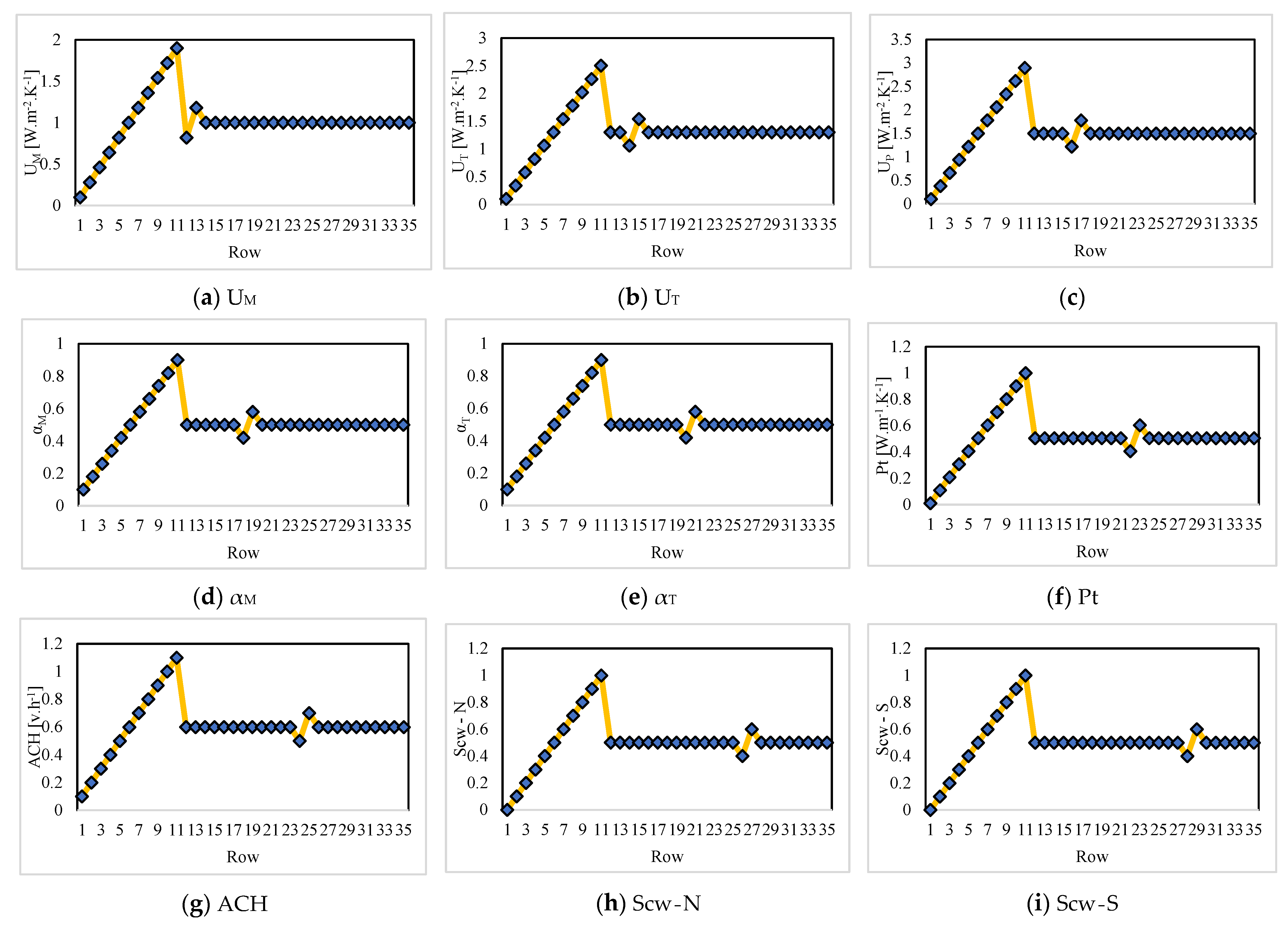
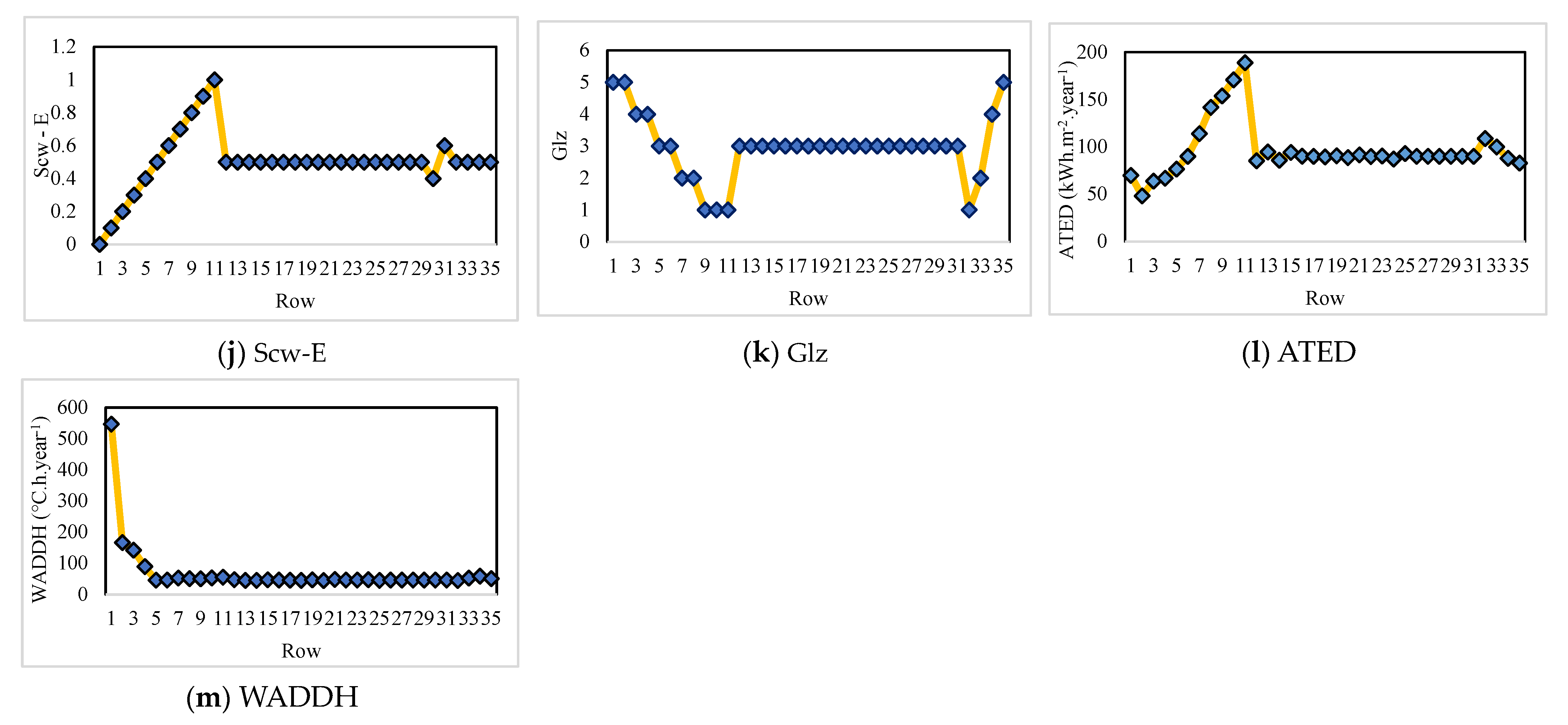

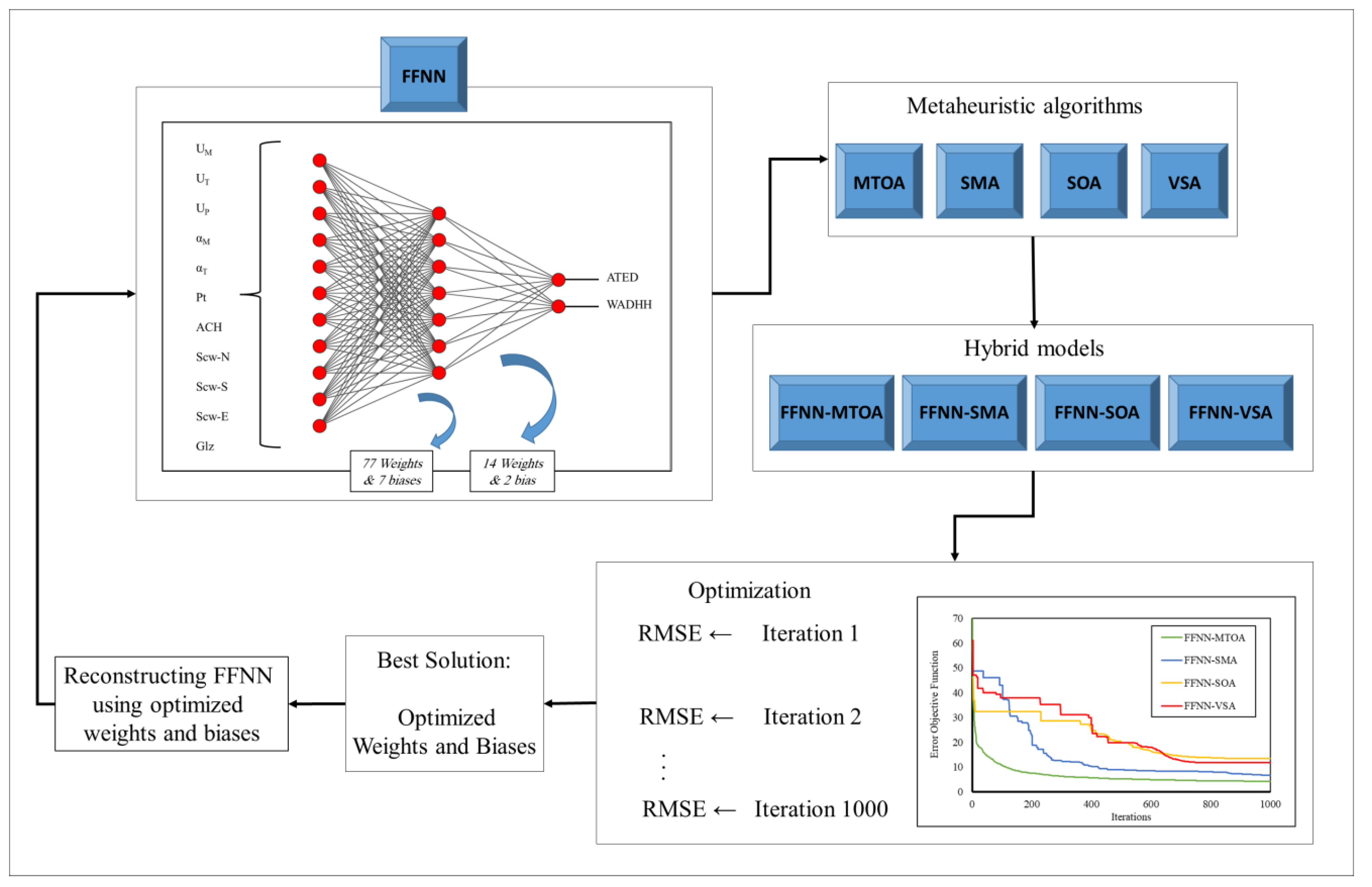

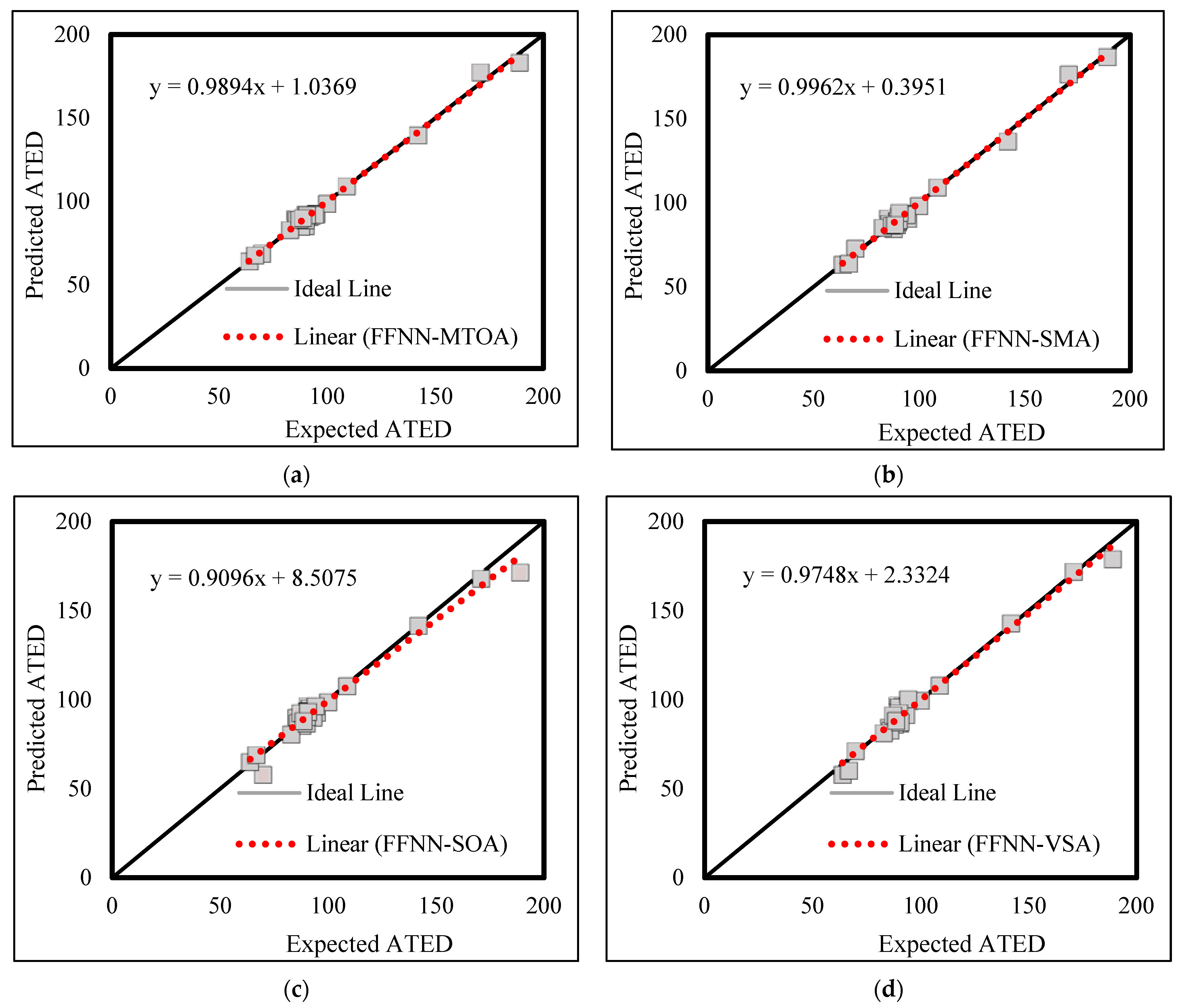
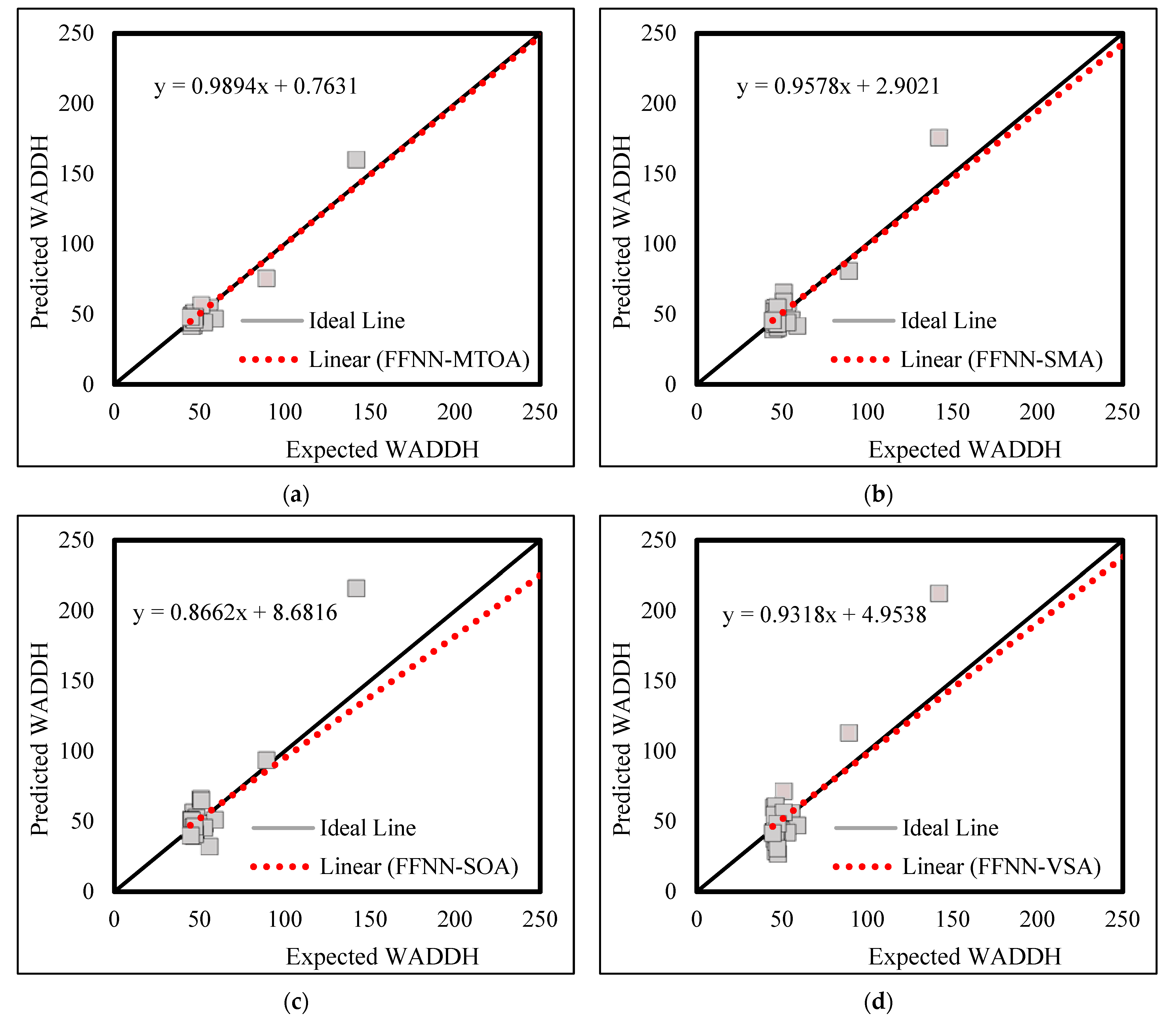
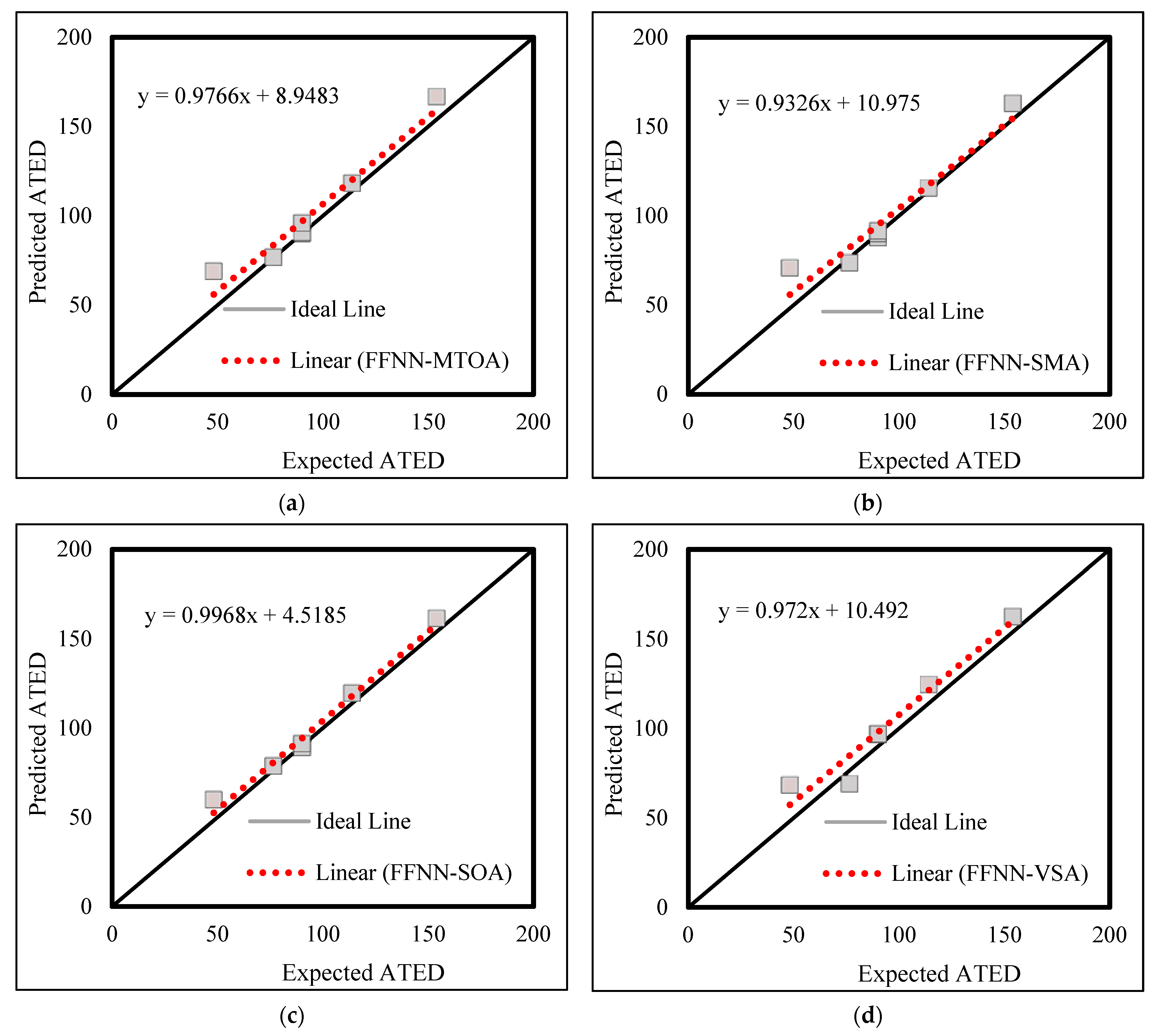

| Group | Parameter | Abbreviation |
|---|---|---|
| Input | External walls’ coefficient of transmission | UM |
| Roof’s coefficient of transmission | UT | |
| Floor’s coefficient of transmission | UP | |
| External walls’ coefficient of solar radiation absorption | αM | |
| Roof’s coefficient of solar radiation absorption | αT | |
| Thermal bridges’ linear coefficient | Pt | |
| Rate of air change | ACH | |
| North-facing windows’ coefficient of shading | Scw-N | |
| South-facing windows’ coefficient of shading | Scw-S | |
| East-facing windows’ coefficient of shading | Scw-E | |
| Glazing | Glz | |
| Target | Annual thermal energy demand | ATED |
| Annual weighted average discomfort degree-hours | WADDH |
Disclaimer/Publisher’s Note: The statements, opinions and data contained in all publications are solely those of the individual author(s) and contributor(s) and not of MDPI and/or the editor(s). MDPI and/or the editor(s) disclaim responsibility for any injury to people or property resulting from any ideas, methods, instructions or products referred to in the content. |
© 2023 by the authors. Licensee MDPI, Basel, Switzerland. This article is an open access article distributed under the terms and conditions of the Creative Commons Attribution (CC BY) license (https://creativecommons.org/licenses/by/4.0/).
Share and Cite
Gong, Y.; Zoltán, E.S.; Gyergyák, J. A Neural Network Trained by Multi-Tracker Optimization Algorithm Applied to Energy Performance Estimation of Residential Buildings. Buildings 2023, 13, 1167. https://doi.org/10.3390/buildings13051167
Gong Y, Zoltán ES, Gyergyák J. A Neural Network Trained by Multi-Tracker Optimization Algorithm Applied to Energy Performance Estimation of Residential Buildings. Buildings. 2023; 13(5):1167. https://doi.org/10.3390/buildings13051167
Chicago/Turabian StyleGong, Yu, Erzsébet Szeréna Zoltán, and János Gyergyák. 2023. "A Neural Network Trained by Multi-Tracker Optimization Algorithm Applied to Energy Performance Estimation of Residential Buildings" Buildings 13, no. 5: 1167. https://doi.org/10.3390/buildings13051167
APA StyleGong, Y., Zoltán, E. S., & Gyergyák, J. (2023). A Neural Network Trained by Multi-Tracker Optimization Algorithm Applied to Energy Performance Estimation of Residential Buildings. Buildings, 13(5), 1167. https://doi.org/10.3390/buildings13051167






